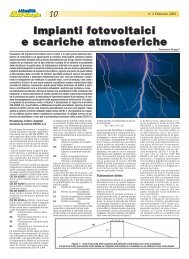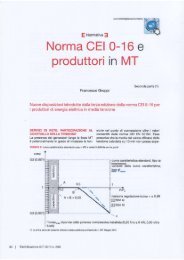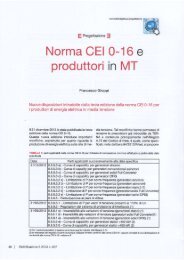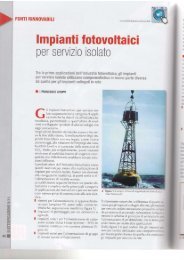A MONITORING SYSTEM FOR GRID-CONNECTED PV ... - Sunsim.it
A MONITORING SYSTEM FOR GRID-CONNECTED PV ... - Sunsim.it
A MONITORING SYSTEM FOR GRID-CONNECTED PV ... - Sunsim.it
Create successful ePaper yourself
Turn your PDF publications into a flip-book with our unique Google optimized e-Paper software.
A <strong>MONITORING</strong> <strong>SYSTEM</strong> <strong>FOR</strong> <strong>GRID</strong>-<strong>CONNECTED</strong> <strong>PV</strong> PLANTS<br />
F. Groppi<br />
CESI, Via N. Bixio 39, I-29100 Piacenza, Italy<br />
+39 02 2125.4349, +39 02 2125.4387, groppi@cesi.<strong>it</strong><br />
G. Drera<br />
CESI, Via Rubattino 54, I-29134 Milano, Italy<br />
+39 02 2125.5701, +39 02 2125.5626, drera@cesi.<strong>it</strong><br />
Abstract – The growing diffusion of small grid-connected <strong>PV</strong> plants in households has generated the<br />
need of easy-to-use mon<strong>it</strong>oring systems, particularly looking at people that want to be informed quickly<br />
and easily on the contribution of their plant to the family energy balance.<br />
Embedded mon<strong>it</strong>oring systems that inverter manufacturers usually propose are undoubtedly qu<strong>it</strong>e<br />
effective on a technical point of view, but often they require a PC to fully explo<strong>it</strong> their performances.<br />
Furthermore, they are focused on the <strong>PV</strong> plant and not on the dwelling electric system.<br />
For these reasons, CESI has recently developed a system aimed to perform an easy mon<strong>it</strong>oring of the AC<br />
behaviour of single-phase grid connected <strong>PV</strong> plants.<br />
The mon<strong>it</strong>oring system is totally independent from the equipment which composes the <strong>PV</strong> plant (<strong>PV</strong><br />
modules and inverter) and <strong>it</strong>s configuration (single inverter or multi-inverter). Furthermore, <strong>it</strong> has been<br />
conceived for an easy operation and so <strong>it</strong>s technology is based on a touch-screen 8” mon<strong>it</strong>or, w<strong>it</strong>h an<br />
interface fully understandable also by people that are not very familiar w<strong>it</strong>h electric and energy concepts.<br />
The system is composed by a grid analyser that measures AC voltage, <strong>PV</strong> power, loads power and the<br />
power exchanged w<strong>it</strong>h the grid, along w<strong>it</strong>h a “smart” terminal w<strong>it</strong>h a 8” colour touch-screen. The<br />
software application has been developed on a PC platform.<br />
This work is being supported by the Fund appropriated for Research on the Electric System, as provided<br />
for the decree of the Minister of Industry, Trade and Handicraft of January 26, 2000, modified on April<br />
17, 2001, which defines the general costs and obligations regarding the electric system.<br />
1. GENERAL ARCHITECTURE OF THE<br />
<strong>MONITORING</strong> <strong>SYSTEM</strong><br />
The aim of the project was to develop a system which<br />
could perform the mon<strong>it</strong>oring of <strong>PV</strong> plants connected to<br />
LV grid, giving the possibil<strong>it</strong>y to display the main electric<br />
values relevant for the photovoltaic plant as well as for<br />
the home plant.<br />
The system has been studied for single-phase (230 V)<br />
systems preferably located in homes, whose maximum<br />
power is often comparable w<strong>it</strong>h the maximum power<br />
supply obtainable from the electric company. In a<br />
s<strong>it</strong>uation like this <strong>it</strong> is useful to measure and keep track of<br />
the following quant<strong>it</strong>ies:<br />
Easy to use<br />
Easy to install<br />
Effectiveness in data representation<br />
Flexibil<strong>it</strong>y of use<br />
Cost not too high<br />
The system is composed by a grid analyser for data<br />
collection and a “smart” device w<strong>it</strong>h a 8” screen for<br />
memorisation and displaying. Ne<strong>it</strong>her keyboard or mouse<br />
are needed because the “smart” device has a “touchscreen”<br />
interface.<br />
Power and energy produced by the <strong>PV</strong> plant<br />
Power and energy to the internal loads<br />
Power and energy taken or delivered to the public<br />
grid<br />
Furthermore, on the basis of experiences and from an<br />
analysis of the needs of <strong>PV</strong> producers, the following<br />
characteristics have been considered as particularly<br />
important:
2. HARDWARE CONFIGURATION OF THE<br />
<strong>MONITORING</strong> <strong>SYSTEM</strong><br />
The mon<strong>it</strong>oring system has been conceived for having<br />
only a minimal interaction w<strong>it</strong>h the existing electric<br />
energy distribution plant and to be used also “by a child”<br />
in a totally safe way.<br />
The electric diagram is shown in the following drawing.<br />
The 8” smart screen may be placed in the most su<strong>it</strong>able<br />
spot of the home.<br />
3 SOFTWARE CONFIGURATION OF THE<br />
<strong>MONITORING</strong> <strong>SYSTEM</strong><br />
The mon<strong>it</strong>oring system has been programmed on a PC<br />
by using a special language provided by the builder of the<br />
8” smart screen.<br />
Electric components may be lodged in a simple panel<br />
su<strong>it</strong>able for domestic plants along w<strong>it</strong>h normal sw<strong>it</strong>ches<br />
and protections.<br />
The following figure shows the prototype built at CESI<br />
and now located in the photovoltaic experimental area.<br />
However, this simple equipment reproduces completely<br />
the electric panel and the screen that may be installed in a<br />
house or apartment.<br />
The communication protocol between the smart screen<br />
and the data collector is the MODBUS standard.<br />
The smart screen may provide further expansions and<br />
system improvements because <strong>it</strong> may communicate w<strong>it</strong>h<br />
many peripherals (see the figure taken from technical<br />
manuals).<br />
The software has been developed w<strong>it</strong>h the aim to<br />
provide a very simple interface to the user and so <strong>it</strong> is
possible the representation of instantaneous values as<br />
well as past trends by means of diagrams, tables and<br />
histograms.<br />
Data sampling is made at 1 minute interval by the data<br />
collector; every 15 minutes the system performs an<br />
average of valid samples and records the result in the<br />
internal memory of the system.<br />
Software development cr<strong>it</strong>eria that have been adopted,<br />
assure a good management of the 640480 pixel screen<br />
w<strong>it</strong>h 128 colours and a lim<strong>it</strong>ed RAM (16 kb).<br />
The system developed by CESI gives the possibil<strong>it</strong>y to<br />
manage the following pages and their associated<br />
functions:<br />
4. OPERATION OF THE <strong>MONITORING</strong> <strong>SYSTEM</strong><br />
4.1 In<strong>it</strong>ial page<br />
In<strong>it</strong>ial page<br />
Plant layout w<strong>it</strong>h instantaneous values of line<br />
voltage and power flows<br />
Set-up page for date and time, protected by a<br />
password entry page<br />
4 Pages which show 15-minutes values of line<br />
voltage, energy from <strong>PV</strong>, energy to loads and<br />
energy exchanged w<strong>it</strong>h the public grid (24 hours)<br />
4 Pages which show daily values of line voltage,<br />
energy from <strong>PV</strong>, energy to loads and energy<br />
exchanged w<strong>it</strong>h the public grid (28, 30 or 31 days)<br />
4 Pages which show monthly values of line<br />
voltage, energy from <strong>PV</strong>, energy to loads and<br />
energy exchanged w<strong>it</strong>h the public grid (12 months)<br />
4 Pages w<strong>it</strong>h a bar graph which show 15-minutes<br />
trends of line voltage, energy from <strong>PV</strong>, energy to<br />
loads and energy exchanged w<strong>it</strong>h the public grid<br />
(24 hours)<br />
4 Pages w<strong>it</strong>h a bar graph which show daily trends<br />
of line voltage, energy from <strong>PV</strong>, energy to loads<br />
and energy exchanged w<strong>it</strong>h the public grid (28, 30<br />
or 31 days)<br />
4 Pages w<strong>it</strong>h a bar graph which show monthly<br />
trends of line voltage, energy from <strong>PV</strong>, energy to<br />
loads and energy exchanged w<strong>it</strong>h the public grid<br />
(12 months)<br />
A page, w<strong>it</strong>h up to 8 sub-pages, useful for swift<br />
annotations and drawings<br />
Several pages which contain short descriptions and<br />
photos of photovoltaic buildings in the world<br />
4.2 Plant’s layout w<strong>it</strong>h istantaneous values of line voltage<br />
and power flows<br />
4.3 Electric panel
4.4 <strong>PV</strong> power generated – bar graph<br />
4.5 Line voltage bar graph<br />
4.6 Set-up page: User acknowledgment








